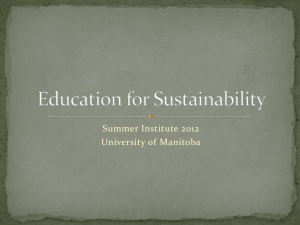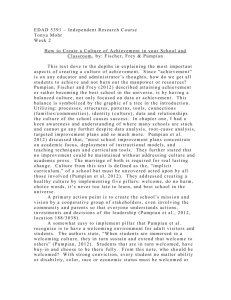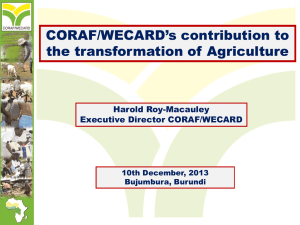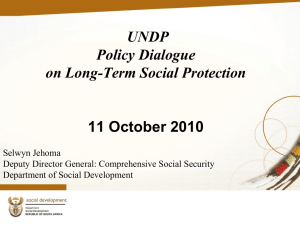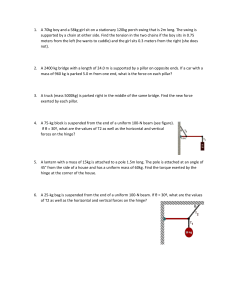Slide 1 - AIARD Association for International Agriculture & Rural
advertisement
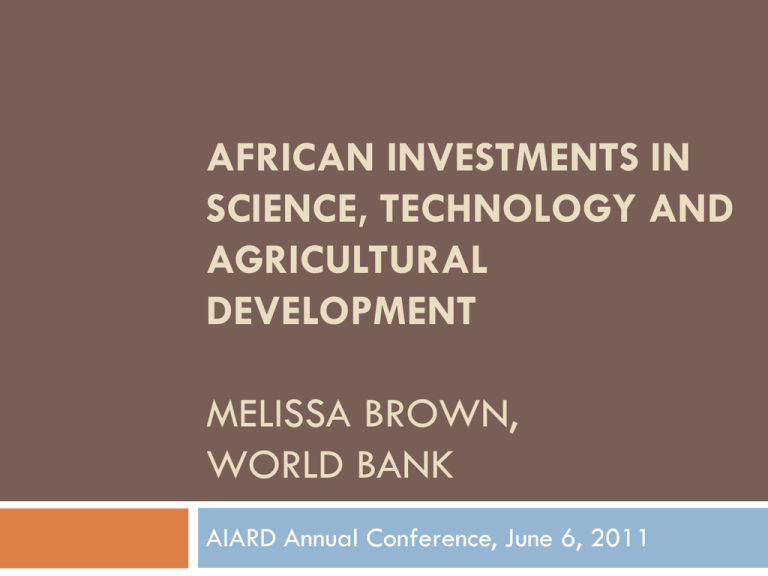
AFRICAN INVESTMENTS IN SCIENCE, TECHNOLOGY AND AGRICULTURAL DEVELOPMENT MELISSA BROWN, WORLD BANK AIARD Annual Conference, June 6, 2011 Presentation Outline CAADP – A Framework for Country Led Initiatives and Investments Overview of World Bank Support to Investments in Agriculture in Africa Investments in Science, Technology and Agricultural Development in Africa CAADP - A FRAMEWORK FOR COUNTRY LED INITIATIVES AND INVESTMENTS What is CAADP? The Comprehensive Africa Agricultural Development Program Not a program – a Framework An African framework - NEPAD/AU vision and strategy for agriculture CAADP calls for: Renewed focus on the importance of agriculture Need for improved strategies, plans, programs, and policies More investment in agriculture African Ownership CAADP Targets and Principles Targets: 6% growth in agriculture and allocation of 10% of government budget to agriculture Guiding Principles: Country-led Comprehensive - cross-sector/ cross-government Multi-stakeholder engagement - CSOs, Private sector, Govt, Farmers Evidence-based planning Peer review, mutual accountability and M&E Regional complementarity Pillars and Frameworks Pillar 1 – Land and Water Management Pillar 2 – Markets and Infrastructure Pillar 3 – Food Security Pillar 4 – Agricultural Productivity CAADP Encourages: Countries to launch …. ….. “Planning Processes” ….. ….. Informed by CAADP Principles and Tools ….. ….. leading to ….. More Effective Scaled-Up Programs Better Policies Growth Poverty Reduction CAADP is : a way to harness continental resources to support national and regional planning and investments (capacity building!) WORLD BANK SUPPORT FOR AFRICAN AGRICULTURE Context - African Agriculture since 2009 Global food (and fertilizer) prices Refocused SSA Governments Commitments high (Aquila), delivery lags (GAFSP finance, other)? Private sector interest and finance has energized definition of country-owned programs, raised expectations for external financing, investment plans of variable quality, process transactions-intensive Donor flows investing in agriculture, but politicized with over-reliance on subsidies, and weak investment programs CAADP platform spikes in 2008 & 2010 threaten the poor, and social stability, offer potential gains to farmers positive FDI trends (but data are poor), and second-generation policy frameworks (sector taxation->regulation, investment climate) still constrain Outcomes Fragile gains in SSA on sector GDP, land and labor productivity, and yield trends, but still below targets and insufficiently widespread across countries Progress: Sector Performance 1220 1200 Cereal Yields (kg/ha) 5 yr moving average Real Agricultural GDP (28 countries value weighted) 4.5 1180 4.0 1160 3.5 1140 1120 1100 3.0 # of countries > 5%/yr 2.5 1080 2.0 1060 1.5 1040 1.0 1020 0.5 1000 8 3 5 4 4 0.0 2000-04 Sources: ReSAKSS Comprehensive Monitoring and Evaluation Report, April 2010 2001-05 2002-06 2003-07 2004-2008 2009 Scale-Up Strategy Goal Higher SSA agriculture sectors’ growth and improved food security Current Strategy Focus Double lending over 2009-2010 Four pillars – land and water management, agricultural markets and infrastructure, food security and vulnerability, agriculture technology Horizontal beams – sector-wide policies, gender, climate change Strengthen the CAADP process How Instrument innovation Country-owned sector programs Donor coordination Regional programs WB Scale-Up in Financing SSA Agriculture (million USD) FY08 TOTAL FY09 464 1,684 FY10 FY11 847 FY12 1,450 797 Building pipeline from FY12 a priority with IDA16 increase. IDA Commitment 434 1,494 754 1,273 783 Grant 30 190 93 177 14 GFRP Funding 10 501 85 20 - WB Portfolio – SSA Agriculture (US$ Millions) Pillar Africa CA EA SA WA Total Pillar 1 10.12 9.30 283.12 55.39 143.82 501.74 Pillar 2 10.70 58.55 80.29 94.50 356.94 600.98 6.50 401.96 27.77 50.14 486.36 Pillar 3 Pillar 4 Aggregate 76.95 48.62 365.81 90.32 328.82 910.52 Cross-cutting 41.81 11.74 95.69 12.80 30.56 192.60 139.59 156.90 1,478.81 333.75 1,259.42 3,368.46 TOTAL LOOKING FORWARD: ALIGNMENT WITH NEW AFRICA STRATEGY Pillars and Foundation Competitiveness and Employment, Vulnerability and Resilience, and Governance and Public Sector Capacity provide a good framework for addressing the sector challenges Partnerships With governments, private sector, development actors Scale and scope of the problem demands and use our catalytic power and expertise to leverage other partners Learn from and build on existing partnerships (CAADP, AfdB, AUC, Bilateral, civil society, etc) Mobilize partners to deepen and accelerate support to Africa Agriculture (crowding in private and other public resources) Knowledge Connector of knowledge in Agriculture and Agri –business development Strengthened impact of AAA South-South partnerships (e.g. Brazil) Political economy analysis of incentives facing actors in reform process Finance Leverage WB , specially IDA resources, Development Partners, Private sector and PPP, Domestic resource mobilization Page 15 Looking Forward: Strengthening the CAADP Pillars Continued Strategic Focus Four main pillars: land and water management, agricultural markets and infrastructure, food security and vulnerability, agriculture technology Horizontal beams – policies, gender, climate change Main Adjustments Land and water operations implementation – updating the irrigation business plan Agribusiness platform – for better leveraging of private investment and increased participation Public expenditure policy engagement – cross-pillar program strengthening through CAADP MDTF and BMGF trust fund for analytical work (9 countries underway in 2011) Pillar I Support in the Bank Land Sustainable land management – rainfed land and pasture management; TerrAfrica Investing in land administration Titling, registration and cadastral capacity for small and large farm enterprises Innovating in community mapping and land taxation Engaging on policies for responsible FDI in land for agriculture, linked to land administration capacity Water Irrigation business plan – mid-term review just completed Scope exists for further scale-up, better if projects avoid small irrigation components Climate change impact on priorities Water management Soil carbon Good practice projects Ghana Land Administration Zambia Irrigation Development and Support Ethiopia Irrigation and Drainage Pillar II Support in the Bank Diversification, value chain deepening extensive analytical foundations and piloting, now moving into operational work Private investment flows – mobilizing and harnessing; PPP Program integration Agribusiness Platform (AR, FP, IFC, with infrastructure) Piloting integrated project designs – four pipeline projects (Ghana, Burkina Faso, Senegal, Malawi) Increasing attention to safeguards: palm oil, GMOs, monoculture pressure on biodiversity Africa Union initiative Focusing on scale-up Still developing technical tools Good practice projects Ethiopia Agricultural Growth Program Nigeria Commercial Agriculture Mali Agricultural Competitiveness and Diversification Pillar III Support in the Bank GFRP – resources mostly allocated; shifting to longer-term impacts on food production productivity and marketing efficiency Community-Driven Development Projects Food security for the very vulnerable Communities with declining resource bases Maritania, Chad, Niger, Madagascar (PSDR), Nigeria (FADAMA) Evolution: away from too-open menu for broad livelihoods, sharper focus on agriculture and more access to better techniques Disaster Dimension Early warning systems for drought (Kenya, Ethiopia, Malawi, Madagascar) Climate-related vulnerabilities and adaptive responses Productive Safety Nets Opportunities for complementarity with HD, but better role focus (who does what) possible on food security Good practice projects Mauritania Community-Based Rural Development FADAMA Development Project III Madagascar Rural Development Support Looking Forward: Emerging Issues Private investment flows Capturing climate change finance for agriculture Main opportunity is soil carbon, following on the REDD path M/E and statistics agenda Tracking - household, domestic commercial, FDI Facilitating – “crowding in” with public investment, and with business environment Link to employment generation Investment in sector capacity within national statistical strategies; key external partners are FAO and BMGF Mechanization High political profile but still seeking workable strategies. Donor tractor aid poorly used, and private leasing services not taking off. Looking Forward : Partnership and Working with CAADP Commitment to the framework Prudence on the transactions costs, and managing expectations Build on Country Compact progress Strengthen the technical review process of national investment plans Expand on public expenditure analysis for fact-based consensus-building Emphasize the need to “crowd in” responsible private investment through public goods and services provision Expand investment at regional level Monitoring and evaluation CAADP PILLAR IV The Productivity Challenge Evidence Summit - Conclusions from Agricultural Technology Adoption and Productivity Growth in Sub-Saharan Africa Presentation (D Byerlee): Little evidence of a productivity take off Significant adoption but often small and localized Should not focus just on food staple technologies Cash crops, horticulture, livestock, fish Not just yields but labor productivity Labor saving technologies? Diversity of conditions and technologies No ‘silver bullet’ or transformative technologies Focus should be on: Investing in generating more and better technologies and Enabling policies and institutions for adoption Capacity Constraints within Science and Technology systems Africa’s technology generation and dissemination systems often face: Weak human capital Poor facilities Low levels of overall investment Leading to High levels of fragmentation /isolation among practitioners Financing spread over wide range of priorities Africa’s 2008 Ag. R&D investment totaled $1.7 billion - equal to Brazil - but spread over more than twice as many scientists (ASTI) CAADP Pillar IV Advocates: Renewing the ability of ag. technology systems to efficiently and effectively generate and adapt new knowledge Technology delivery systems that rapidly bring in innovations to farmers and agribusiness Enhanced rate of adoption of technologies Through: Larger investments in agricultural research, extension and education systems Institutional reforms that increase efficiency and effectiveness of research and extension spending Harmonization of external support FAAP – Implementation of Pillar IV Framework for Africa Agricultural Productivity (FAAP) - Guiding Document FAAP is a guide but also an “agreement” FAAP provides guiding principles on best practice to improve performance of agriculture technology systems The adoption of FAAP has allowed a broad group of development partners to start scaling up support and presents an opportunity for harmonization of that support FAAP Principles Empowerment of end-users Planned subsidiarity Pluralism in the delivery of agricultural research, extension, and training services Integration of agricultural research with extension services, the private sector, training, capacity building, and education programmes Introduction of cost sharing with end users Integration of gender considerations at all levels FAAP Calls for: Scaling up investments in national and regional approaches Pillar IV Support within the Bank Research projects o Regional projects designed to achieve critical mass and facilitate spillover take-up of results o National system support – rebuilding, while forcing the link to dissemination and extension; no free-standing agricultural research projects o Spill-in through South-South partnerships (EMBRAPA and innovation grants) Extension o Designs are tailored to constraints e.g. demand (Uganda, Rwanda), supply (Ethiopia), effective diffusion from research (WAAPP), and input/irrigation related (Nigeria Commercial Agric and FADAMA; and WUA elsewhere) Leveraging resources - large MDTF Biosafety capacity o Regulatory underpinnings for new seed technologies; national and regional capacity being built Climate change - impacting research/extension priorities Good practice projects o West/East Africa Agriculture Productivity Projects o West Africa Regional Biosafety Project WB Commitments to Pillar 4 (US$ Millions) Breakdown of Pillar 4 Column1 Pillar 4 research 274.52 Pillar 4 extension 625.41 Pillar 4 education 10.89 Pillar 4 Aggregate($millions) 910.52 Regional Agricultural Productivity Programs: Core Approach Shared efforts leading to greater efficiency – increased specialization Development of critical mass Taking advantage of existing capacity - development of existing sub-regional centers of excellence Opportunities center on shared themes that have sub regional importance identified by the participating countries Regional Agricultural Productivity Programs: Close Linkages to SROs CORAF WAAPP ASARECA EAAPP CCARDESA SAAPP New Initiatives in Agricultural Education and Training Working Group - RUFORUM, ANAFE, FARA, NPCA IDA Regional Project on Tertiary Agricultural Education MDTF to support university partnerships – (USAID, France, DANIDA, others?) Looking Forward Economic Development Perspective Need to Scale-up Pillar 4 investments – long-term payoff Need to do this through building African institutions Invest at both regional and country level CAADP provides foundation Development Community considerations Need to demonstrate document impact – short term gains and MDG gains Need to demonstrate efficiency in use of funds Thank you !
